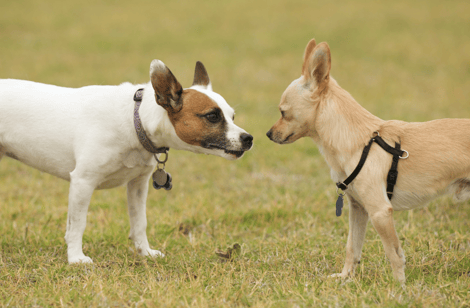Canine Companion Guide: How to Socialize a Dog

Dogs are unique, so there's no single way to socialize every dog. But most experts agree that taking it slow and understanding dogs’ body language fosters harmonious relationships between dogs, people, and other pets.
There are many resources to help pet parents socialize their dogs, including books, websites, classes, and professional trainers. However, not all resources or trainers lead to well-behaved, social dogs.
But why socialize your dog? Don’t dogs pick up proper behavior from basic training and through interactions with their people and other household or neighborhood pets? Not exactly.
What is Socialization?
Socialization means learning the skills needed to get along with and fit into society. It’s as important for dogs as it is for people. According to expert pet behaviorist Christopher Pachel, DVM, DACVB, CABC, of the Animal Behavior Clinic in Portland, Oregon, well-socialized dogs have less:1
- Anxiety
- Fear-related aggression
- Noise phobia
- Reactivity
- Handling issues such as grooming, nail trimming, and restraint
Well-socialized dogs have less stress, interact well with people and other animals, and have better mental and physical health!2
Puppy Socialization
Raising a puppy is a lot of work, but the good news is that you will be present for the puppy’s formative experiences.
Dr. Pachel says the ideal time to socialize puppies is between 3 and 16 weeks old. During this time, socialization can develop their motor skills, expand their social awareness, and give them experiences they can tolerate. It leads to better physical and mental development, including stronger hearts and increased stress tolerance.1 If you want to get your dog from a breeder, it’s important for you to choose a breeder who socializes the puppies in their care.
It’s up to the people who live with the puppies to introduce them to as many different kinds of people, animals, experiences, and environments as possible while they are young. Puppy socialization classes are a fun way to get your pup off to a good start because they provide contact with people and other pets at the right developmental time.
Whether in a class or just in life, puppies should be introduced to: 1
- Other dogs, puppies, and pets
- People of different ages, races, and abilities (for example, children, crutches, and wheelchairs)
- Veterinary equipment like stethoscopes and scales
- Grooming equipment like toothbrushes, brushes, and nail clippers
- New places
- Unfamiliar noises
You’ll need to start slowly and allow the puppy to understand the situation. Many trainers suggest giving the puppy a treat right after it calmly approaches a new person or experience. In some classes, for example, a trainer will put on a winter hat, gloves, sunglasses, or a pair of crutches and let the puppy come and sniff.
The puppy's body language is one of the most important things to watch. If they cower or back away, don’t force it. They should feel safe, secure, and encouraged by their owner.
Old Dogs Can Learn New Tricks
If you have an adult dog, there are still plenty of ways to socialize them. Be prepared and know that socializing an older dog is harder than socializing a puppy because older dogs may have missed out on proper interactions during puppyhood. But don’t worry; it’s never too late to socialize a dog. Be sure to start slow and stay positive. Dogs pick up on our stress and worry, so your positive attitude will help.
Your veterinarian can help you navigate behavior issues with older dogs. The American College of Veterinary Behaviorists' book Decoding Your Dog has recommendations for tough situations.
Most experts recommend lots of walking, which is great for humans and pets. Take your dog to new places and let them sniff. They get fresh air, exercise, and mental stimulation from all the new sights and smells.
Positive Reinforcement
Rewarding dogs for good behavior works much better than punishing them for bad behavior. When your dog is relaxed and calm, especially in a new situation, give your pup a treat simply because they’re relaxed and calm. Never underestimate the power of yummy treats in dog training. Ignore those who tell you otherwise.
Treats may work if your dog is nervous around new people. Ask the person to avoid eye contact with your dog, which can be challenging, and drop a treat near their feet. If the dog comes over for the treat, they may return for more, and eventually, they might accept one directly from the new person’s hand. Many strong friendships have started like this!
Learning to Speak “Dog”
Dogs communicate with their bodies—wwith us and with other creatures. Socializing dogs is mainly about understanding their body language. This PetMD article introduces the basics of dog body language.
Recognizing dog body language is important because it helps protect people and the dog. If people recognize fearful behavior in a dog, they’ll know not to approach, pet, or excite the dog, helping prevent dog bites. Recognizing your pet’s mood also helps you bond. Knowing that a dog is eager and ready to learn improves training and socialization. Understanding pet body language aids communication, making life more enjoyable for you and your pet.
In general, happy dogs have
- Loose, relaxed stance
- Naturally positioned ears
- A closed, relaxed mouth, or a mouth that is panting in a relaxed way
- Extended, loose, happily wagging tail
On the other hand, fearful dogs show any or all of these and more:
- Stiff limbs and tail
- Pulled-back ears
- Yawning, sneezing, or licking their lips
- Low, tucked tail
- Shaking, grooming themselves, or scratching
Introducing a New Dog
Some households have such a good experience with one dog that they add another. It can be great for dogs to have a canine companion, but the introduction needs to be deliberate and slow.
This article in PetMD shares introducing a new dog to a resident dog.
-
Have the first meeting in a neutral space. Dogs are territorial, so it should ideally be a fenced-in yard or area that neither dog has “claimed” as its territory. A large garage or basement can work if you can’t find an outdoor space.
-
Stay calm and relaxed. Dogs will pick up on your stress or worry.
-
Work with a partner who understands the dog’s body language.
-
Take a walk with both dogs on a leash, and let them walk side by side.
-
When the new dog comes into the home, remove objects that could cause a dog to be reactive or possessive, like bones, food bowls, beds, treats, or toys.
-
Have someone else take the resident dog out for a walk while the new dog explores the space.
-
When the dogs are finally together, monitor their body language closely and separate them if things seem to be getting tense.
-
Make sure each dog has their own bowl, bed, or treat. They are keeping track!
Dog Park Socialization
Some dogs love off-leash dog parks, but others don’t.
“Dog parks aren’t for everyone,” said Dr. Melissa J. Bain of the UC Davis Clinical Animal Behavior Program.3 Aggressive or fearful dogs and puppies who aren’t fully vaccinated shouldn’t visit dog parks, Dr. Bain said.3 But if your dog is a good match for the park, be sure your dog is well-behaved, well-socialized, and fully vaccinated. The upside of dog parks for dogs includes exercise, play, and mentally stimulating experiences.3
While at a dog park, pay attention to your dog’s behavior and body language. and redirect your dog’s attention if needed. A bad experience can lead to trouble, such as fights, injuries, and a dog who doesn’t want to go back to the park.
Get our tips for safely visiting dog parks here.
A Joyful Connection
It’s up to us humans to help our puppies and dogs learn to accept new people, pets, and situations.
As many dog owners will tell you, a walk in the park with a well-socialized dog is one of life’s best experiences.
Reviewed and edited by Dr. Anna's colleague, Dr. Kathy Adamson.
REFERENCES
- Pachel C DVM, DACVB, CABC. Windows of Opportunity: A New Approach to Canine Socialization.
- Wild West Veterinary Conference 2016. VIN.com. Published online October 7, 2015. https://www.vin.com/doc/?id=8276716
- Burns K. Advising clients about dog parks. AVMA. Published September 1, 2006. Accessed February 2, 2024. https://www.avma.org/javma-news/2006-09-15/advising-clients-about-dog-parks

